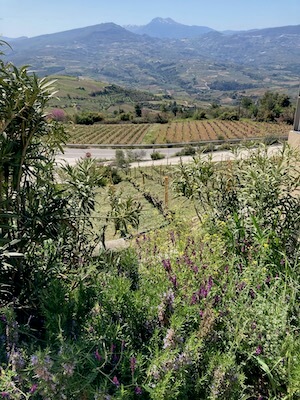Today we returned to Nemea, one of the most prestigious of Greece’s wine growing regions, with its PDO (appellation controllée) for red wines made from Agiorgitiko grape.
First we visited Constantin Gofas, established in 1959s. In the 2000s they built a very attractive winery on the valley floor, which also displayed the art that the family was so proud of, including paintings depicting Hercules and the lion (and the blood that was spilt making wine red), and Saint George. The third generation Konstantinos Gofas now makes the wine. Our guide was Betty, a long standing employee with deep knowledge of the wines. She walked us through vineyards down to the most idyllic spot, where a stream widened in a small glade. It was absolutely delightful and we enjoyed the dappled shade – temperatures are rising every day on this tour, although Betty told us that this January temperatures had dropped to minus 17 Celsius, and some young vines had died.
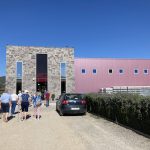
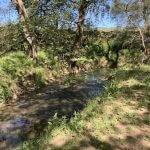
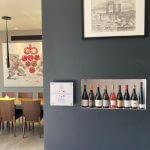
Back in the winery we briefly visited the winery and barrel cellar, before sitting down in another lovely setting behind the winery with superb views across the valley floor to the surrounding mountains.
We tasted their entire range, which was an interesting combination of local and international varieties. At the basic end (€10-12 in Greece) the Mythic River white (blend of Sauvignon Gris and Malagousia) and rosé (Agiorgitiko and Syrah) were fresh and fruity while the Meranyxta white, made from the very rare Kidonitsa grape had more complex flavours and a creamy texture.
Mythic River red, a blend of Cabernet Sauvignon and Agiorgitiko, had lovely savoury flavours, and was a big wine with great fruit and tannins.
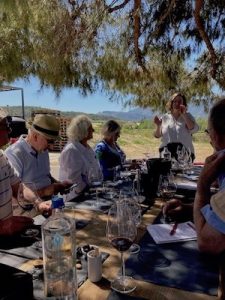
Two PDO Nemea red wines (100% Agiorgitiko) showed the range of styles this grape can achieve – Ktima Gofa Reserve, which had had a year in French oak and a year in bottle was quite pale in colour with both fruity and earthy/smoky flavours and fine tannins, while the Vasilio Grande Reserve from 2016 was deeper in colour, with more concentrated and powerful aromas and flavours. They make very small quantities of the Vasilio, only in the best years, the grapes are sourced from the Koutsi sub region, considered one of the best in Nemea, and it was up to know the most expensive wine we had tasted on the tour at €47/bottle.
Our final wine was the Vin de Zemnes sweet red, a permitted style in Nemea, made from sun dried Agiorgitkio grapes that were so concentrated the wine naturally achieves 15.5% alcohol with lots of residual sugar. 5 years of barrel ageing followed by 5 years bottle maturation has made this a lovely complex, smooth wine, for me a perfect match for chocolate!
Tim had to shoo us onto the bus, it was so hard to leave such lovely wine and fabulous hospitality.
The bus climbed up the side of the valley, through the village of Koutsi, along a road that hadn’t been built when Tim first visited in 2019, to the Seméli Estate. A very famous estate, founded in 1979, originally making wine in Attica near Athens, using sourced grapes, they now own 30ha of vineyards in Nemea and Mantinia, and in 2003 built a superb winery with a stunning outlook over the Nemea valley to the south and the gulf of Corinth to the north. The security guard on the gate was the fist indication of the no-expense-spared approach, thanks to investment from an ex banker, and the winery and visitor area was very much in keeping.
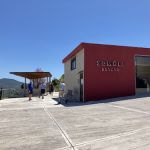
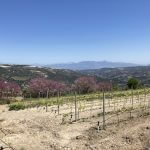
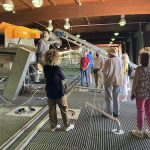
We were met by Yannis, the head winemaker, with Margarita, his assistant, who took us to the top of the site. Yannis explained that the higher sites such as Koutsi, benefit from breezes from the gulf of Corinth, making the growing season longer, while the calcareous soil aids the retention of acidity in the grapes as they ripen.
The winery is built to make use of gravity throughout the process, with grape reception (lots of refrigeration and CO2 to keep the grapes in top condition) happening at the top, the stainless steel tanks in which the wines ferment being the next level down, and the barrel cellar at the bottom). Most of the whites are kept for several months on their lees to enhance the flavours and body of the wine, and 500 barrels, mostly French barriques, are in place to mature both whites and reds. Water is recycled, and solar panels are installed to aid sustainability.
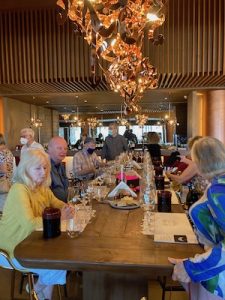
Our tour ended in the barrel cellar and we came up a level to the tasting room, where Yannis took us through a selection of Seméli wines. The Athéria blend of Malagousia and Chardonnay was a lovely introduction, but the Théa Moschofilero (PDO Mantinia) was a revelation. The grapes had been sourced from 30 year old vines in a single vineyard, and one third of the wine had been matured for 6 months in acacia barrels. This was the most concentrated and interesting Mantinia wine I had tasted so far, absolutely gorgeous.
The Delear rosé Syrah/Grenache blend was targeting the Provence pale pink market, but had a lot more colour and flavour than many Provence wines, while the Spondée Syrah/Merlot/Cabernet Sauvignon blend was very attractive – with complex flavours and ripe tannins.
The climax of the tasting was a comparison of two vintages of the Nemea Grande Reserve – Agiorgitiko grapes from the Koutsi region, matured for 18 months in barrique and 24 months in bottle. The current vintage, 2016, had complex red berry fruit/earthy flavours and quite grippy tannins, while the 2003 (their first vintage) was more complex still – lovely forest floor, dried fruit flavours and a silky smooth mouthfeel. A very special wine, we felt very privileged.
More Seméli wine flowed with lunch, all five courses of it (greek salad, courgette tarte, mushrooms with Agiorgitiko sauce, pork, orange cake), and we began to sense defeat – could we manage our final night dinner back in Napflio?
A final gaze at the stunning view, then a much needed doze on the coach home. Tim kindly put dinner back by half an hour so we each made our recovery to the best of our ability – some by yomping up the 1,000 steps to the fort that overlooks Napflio!
Dinner in the Arapakos restaurant was luckily light enough for some of us to manage it, and to exchange some happy memories. We return to Athens tomorrow morning but our flight timing allows us one more visit.
